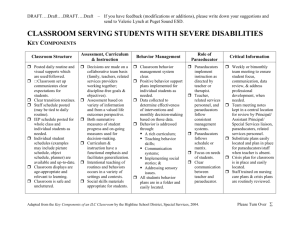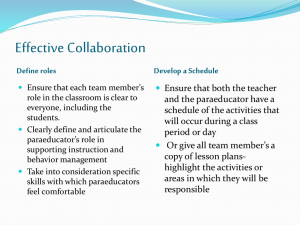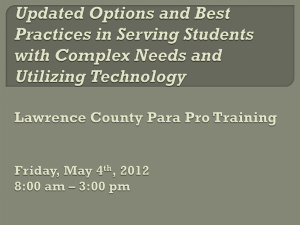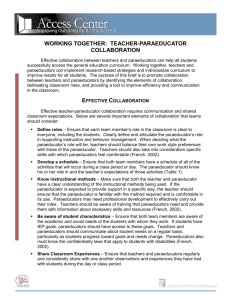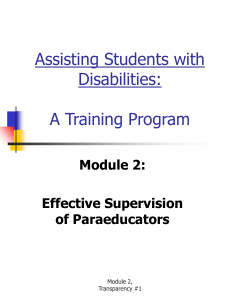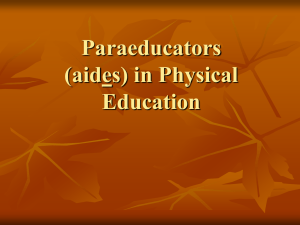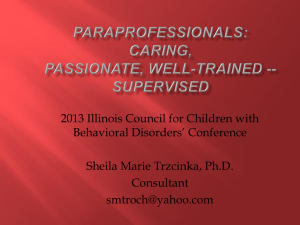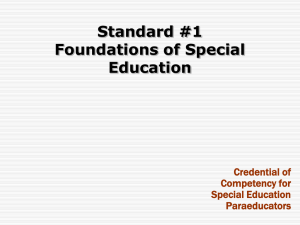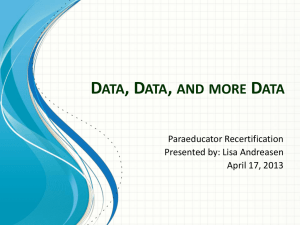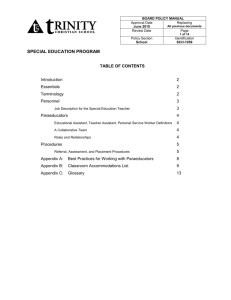Effective Use of Paraeducators
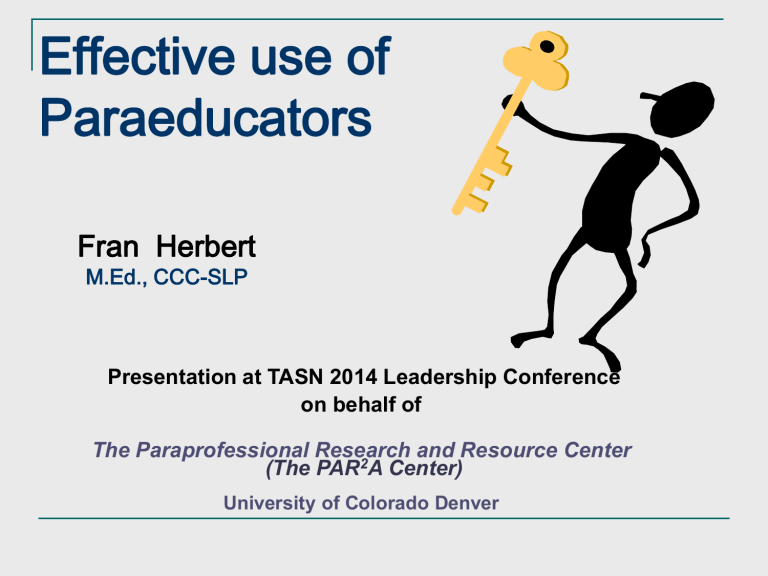
Effective use of
Paraeducators
Fran Herbert
M.Ed., CCC-SLP
Presentation at TASN 2014 Leadership Conference on behalf of
The Paraprofessional Research and Resource Center
(The PAR 2 A Center)
University of Colorado Denver
Most commonly used titles
Paraprofessional
Instructional Assistant
Educational Assistant
Teaching Assistant
Instructional Aide
Aide
Paraeducator
Educational Support Professionals
Early Intervention
Paraprofessionals
2
3
Definitions
Para… means “along side of”
A Paraeducator provides instructional services to students and works under the supervision or direction of a certified or licensed professional who is ultimately responsible for the students and the program.
4
Paraeducators: Who are they?
Turn to the person next to you
Think about the paraeducators in your district /building.
How old are they?
How much money do they make?
What are their educational backgrounds?
What other characteristics are true of them?
Where did they come from? How were they hired?
What implications do these characteristics have for teachers to direct their work?
5
Top 10 Reasons for Employing Educational
Assistants
1.
Complex student population
2.
Need for instructional support
3.
4.
5.
6.
7.
8.
9.
10.
Cost effectiveness
Instructional effectiveness
Community connections
Individualized support
Need to provide related services
Improved teacher-student ratio
Shortages of fully-qualified professionals
Legislation allows / requires it
IDEA and NCLB:
Requirements for Paraprofessionals
The State educational agency establishes and maintains standards to ensure that paraprofessionals and assistants are appropriately and adequately trained and supervised.
NCLB - the paraprofessional must work under ‘direct’ supervision of fully qualified teacher
Job duties are limited to :
•
•
•
•
•
•
One to one tutoring only if it doesn’t prevent the child from receiving instruction by a teacher
Assist in classroom management
Assist in computer instruction
Provide instructional support in a library or media center
Act as a translator
Provide instructional support services
7
NCLB: Regarding Supervision
Paraprofessional must work under
‘direct’ supervision of fully qualified teacher
Job duties are limited to :
• One to one tutoring only if it doesn’t prevent the child from receiving instruction by a teacher
• Assist in classroom management
• Assist in computer instruction
• Provide instructional support in a library or media center
• Act as a translator
• Provide instructional support services
8
Paraprofessional Supervision:
Gaps between Law and Reality
• Laws provide vague and limited descriptions of what paraprofessional supervision entails
• By and large - no clear policies or guidelines at state level around supervision
• Despite guidance from professional organization, teacher preparation programs do not address paraprofessional supervision to the extent it needs attention.
• As a result, teachers remain reluctant to supervise paraprofessionals, and are unprepared to work effectively with them
.
9
Systemic Challenges / Issues
Paraeducator:
Employed in greater numbers
Work away from teachers and have little supervision
Hold increasing amounts of responsibility for instruction
Roles overlap with teachers, are poorly defined
Have little training
Have little information about student goals or needs
Poorly paid, few benefits, little job security, treated poorly
YET! - Are important PR people in the community
Teachers are often unclear about their roles & responsibilities
Teachers perceive a lack of administrative support regarding their role in supervising or directing the work of educational assistants
Potential Problems When Paraeducator work in Special Education
The Paraeducator…
Assumes too much responsibility
Becomes the primary service provider
Lacks specific training
Lacks good supervision and guidance from teachers
Develops “ownership” of the child, loses perspective, ‘mothers’ or overprotects, fosters over-dependence, creates “learned helplessness,” or gives student the “answers,”
Communicates directly with families, leaving teacher out
Fails to provide specific behavioral or academic data to professionals who should make program decisions based on data
Relieves general ed. teachers of responsibility for included student
Creates social barriers between students, causing isolation
Liability
What are the potential liability issues associated with employing paraeducators?
Particularly with regard to the issues already discussed
Managing Risk Proactively
Developing policies to guide teachers and administrators with regards to effective use of paraeducators
Policy categories
1.
2.
3.
4.
Roles & Responsibilities
Supervision of Paraeducators
Training of Paraeducators
Collaboration among team members
Role Clarity
14
Role Clarification
Teacher/Professional Roles Paraeducator Roles
Overall Program Planning (overseeing, IEP goals and objectives, addressing standards, lesson planning, prescribing, managing the instructional environment)
Instruction (based on unit plans, lesson plans, IEPs, remedial literacy plans, 504 plans, other individualized plans)
Assessment (Collecting, coordinating, and interpreting information about the student including current levels of functioning, determination of disability, reporting student progress)
Collaborating (consulting with other professional personnel, meeting coordinating, communication)
Managing Paraeducators (seven components – which are the focus of this course)
Implement instruction in various environments, based on lesson plans provided by the teacher
Reinforce learning with individuals or small groups
Assist individual students- personal care, mobility
Assist with observations/data recording/charting
Assist with ongoing behavior management
Participate in building level duties as assigned by building administrator
Score tests /papers & assist in data collection
Perform clerical tasks
Prepare, produce & maintain instructional materials
Maintain and operate instructional equipment
Help develop schedules
Team participation
15
1. Roles & Responsibilities
Component
Policy
List and define the range of appropriate responsibilities that should be a part of each role
teachers, paraeducators, related service providers….
Clarify the amount of and lines of authority for each position and role
Clarify the levels and types of support available for each position and role
Executive Functions of
Paraeducator Supervision
1.
Providing Orientation
2.
Planning for
Paraeducator
3.
Scheduling
4.
Delegating
5.
Promoting Paraeducator
Growth and Development
6.
Monitoring Performance
7.
Managing the Workplace
17
2: Supervision Policy Components
Establish supervision as a legitimate part of the teacher’s position
Differentiate between supervision and evaluation
Create support systems for teachers who have not been trained to supervise
Determine the logistics of training teachers to supervise (what, when, where)
Identify how administrators provide coaching and support to teachers who supervise educational assistants
Plan how you will monitor the quality of supervision as part of the teacher’s role
What do teachers need to know as supervisors of paraeducators?
Legal, liability, and ethical issues associated with hiring, training, supervising paraeducators
Appropriate / Inappropriate Roles
Professional Team Member Skills
How to Provide Orientation to educational assistants
How to create specific job description for each hired paraeducators
How to (Why) Delegate Tasks
How to Plan for Self and Others
Managing schedules for multiple people
How to Provide On-the-Job Training specific to assigned duties
How to Monitor Performance
How to Manage the Work Environment
3: Paraeducator Training Policy Components
Determine who (teachers & paraeducators) gets what training and when
Create tools for determining paraeducator training needs
Paraeducator and teacher training together is great but is only useful for topics that are of equal relevance to both positions. Keep specific roles of each group in mind as you plan training.
Plan for logistics (when and how training is delivered)
Other considerations – incentives and compensation for paraeducators
Determine how you will get current employees trained on relevant topics
Make explicit the relationship between job responsibilities and training
Plan for Sustainability
Determine how the training program will continue
Where resources will come from
Who has responsibility for running the program
4.
Collaboration Among Team
Members
Policy Components
Ensure general and special education teachers must work together – both responsible for the education of the student and supervision of the paraeducator and programming for the student .
Allow planning time/meetings with paraeducator
Ensure regularly scheduled meetings take place among team members including service providers
Make possible professional development for school based teams on collaboration, problem solving, conflict management etc. along with content specific training suited to each role.
Create a culture of collaboration common understanding that collaboration is not one more thing to do but it is the way to do everything more effectively!
Policy 5: Hiring and Allocation Policy components
Establish systems for identifying student and program support needs
Include consideration of logistics
(where, when, how much, how long)
Explore support possibilities to avoid overreliance on paraeducators
Helpful Resources on Para Supervision
• http://www.paracenter.org
• http://www.paracenter.org/PARACenter/library/
• French, N.K. (2003) Managing Paraeducators in Your School: How to Hire, Train, and Supervise Non-Certified Staff
• Pickett A.L. and Gerlach, K (2006), Supervising Paraeducators in
School Settings: A Team Approach
• Pickett, A. L. Gerlach, K, Morgan, R, and Likins, M (2007).
Paraeducators in Schools: Strengthening the Educational Team
